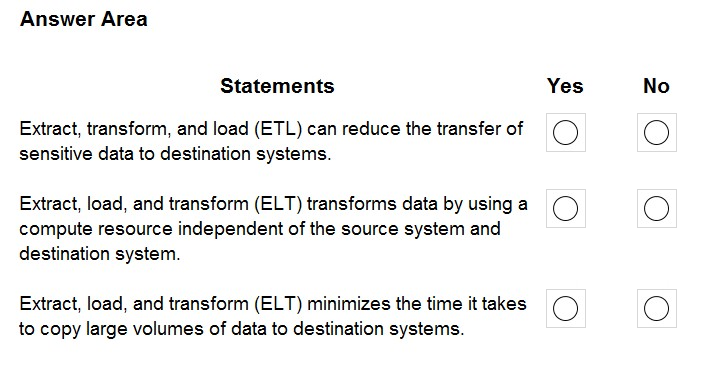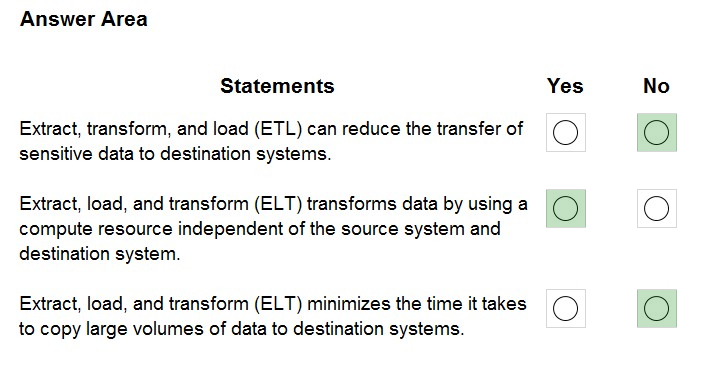HOTSPOT -
For each of the following statements, select Yes if the statement is true. Otherwise, select No.
NOTE: Each correct selection is worth one point.
Hot Area:

HOTSPOT -
For each of the following statements, select Yes if the statement is true. Otherwise, select No.
NOTE: Each correct selection is worth one point.
Hot Area:


Reference:
https://docs.microsoft.com/en-us/azure/architecture/data-guide/relational-data/etl
If you to think logically, Sentence one is yes - You can reduce transfer sensitive data with transformations on data source. Sentence two is No - ELT use the compute resource from destination system. And for last Yes. ELT minimizes time with transformations are going realizaded on target data destination systems.
ETL phases are run in parallel to save time...the last is No
The last one is yes, because ELT processes skip the data copy step present in ETL, which can be a time consuming operation for large data sets. https://docs.microsoft.com/en-us/azure/architecture/data-guide/relational-data/etl
Totally agreed. Answer is Yes, No, Yes
Correct
this is correct answers
Y/N/Y ETL: ...data transformation that takes place usually involves various operations, such as filtering... ELT: ...This approach skips the data copy step present in ETL, which can be a time consuming operation for large data sets... Load and Trasformation are on the same target (https://docs.microsoft.com/en-us/azure/architecture/data-guide/relational-data/etl)
The answer for 2 is NO. The reason being, it says source and destination, those are the keywords. In ELT, the source for transformation is inside DW itself and the destination is also inside DW. So, the compute is same. Answer is NO. The answer for 1 - Yes, as transformation allows fileting data before you put sensitive information in a data warehouse or any destination. This could be really beneficial in for example, banking sector. The answer for 3 - Yes, and the reason is in ETL processes, one of the bottleneck was staging server compute which took a lot of time. Whereas in ELT process, the transformation takes inside DW, which supports massive parallel computing and it removes that bottleneck of slow compute.
I agree, data doesn't have to be copied again once it's in the DW, and it's also transformed in there, so no need for separate transformation tool 1 is yes, data in etl is transformed before being loaded, so could be anonymised before loading
Sì No Sì
I think No , No , Yes : for the first sentence , i found it's crazy to say ETL can reduce transfer sensitive : it's a not a property of ETL , you should define a solution by yourself
in exam 16/06/2023
Yes No Yes
Instead of using a separate transformation engine, the processing capabilities of the target data store are used to transform data. https://learn.microsoft.com/en-us/azure/architecture/data-guide/relational-data/etl the answer : NO / NO / YES
yes, no, yes
ETL can redact and remove sensitive information before putting it into the data warehouse or cloud server. so i think no1 is yes
https://www.striim.com/blog/etl-vs-elt-differences/
https://aws.amazon.com/pt/what-is/etl/
it should be NO,NO,Yes
Yes, No, Yes
no yes yes
De acordo com o BING AÍ, a única resposta correta é: “Extrair, carregar e transformar (ELT) minimiza o tempo necessário para copiar grandes volumes de dados para os sistemas de destino”.
It’s N,Y,Y. N - ETL cannot reduce transfer sensitive data. It transfers across multiple systems exposing sensitive data. Y - ELT uses independent compute system from source as processing is done in Target. Y - ELT minimizes copying over multiple systems.
"Y - ELT uses independent compute system from source as processing is done in Target." ------> the question asks "... of the source AND destination system". please read carefully